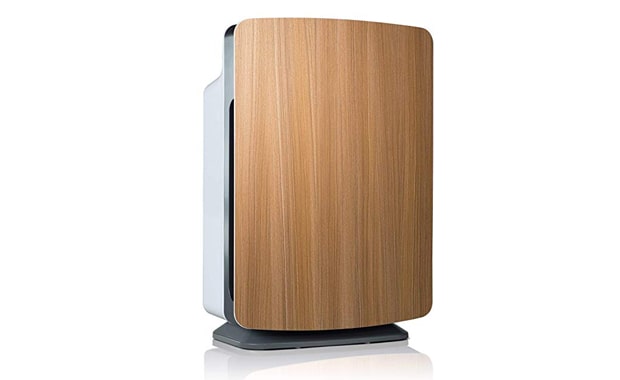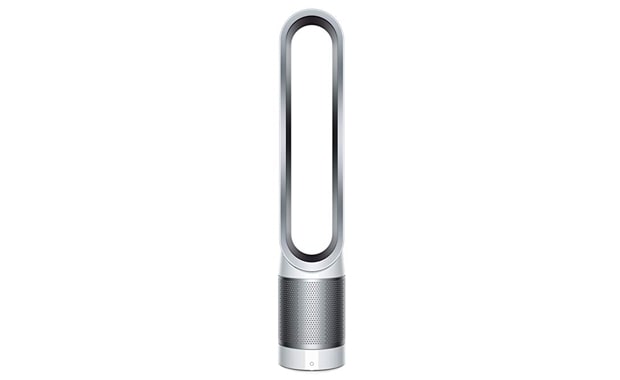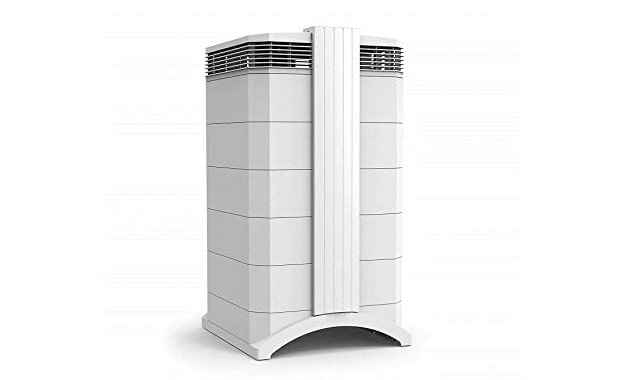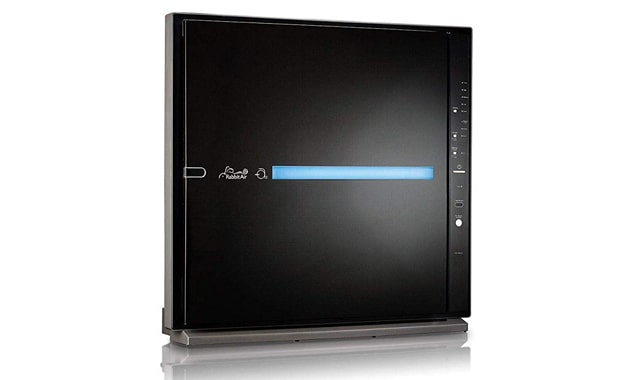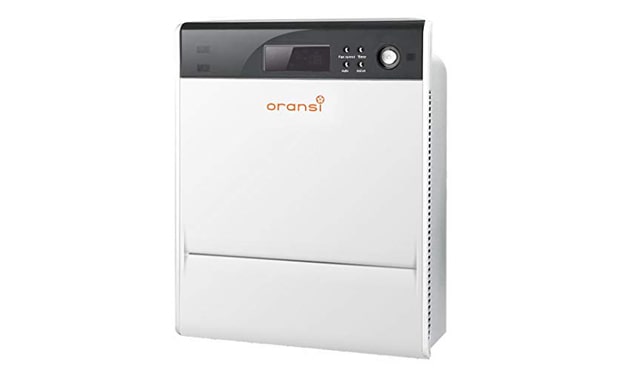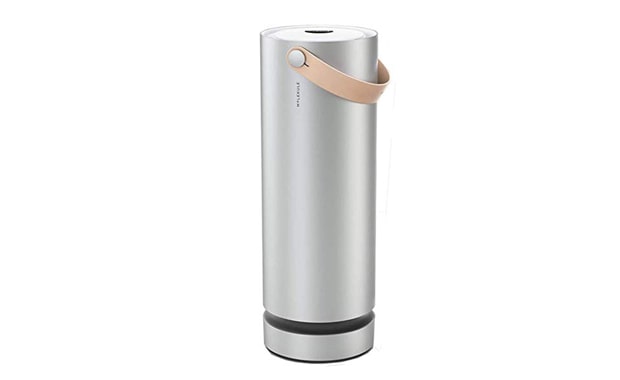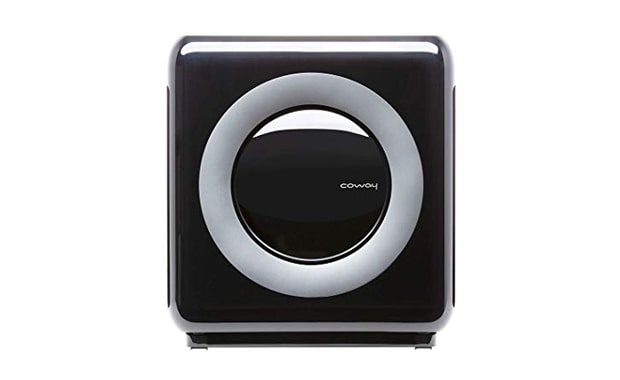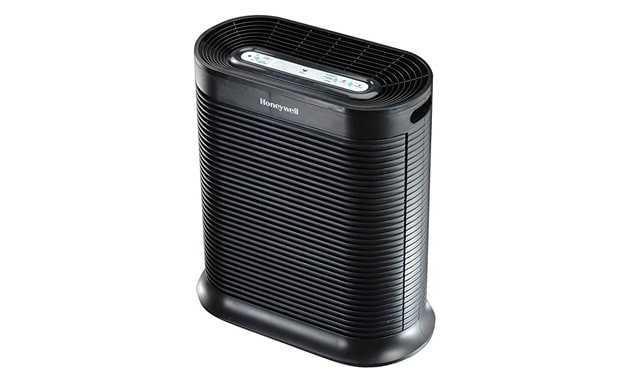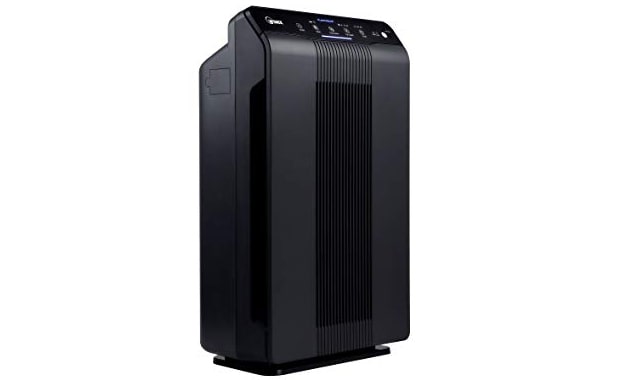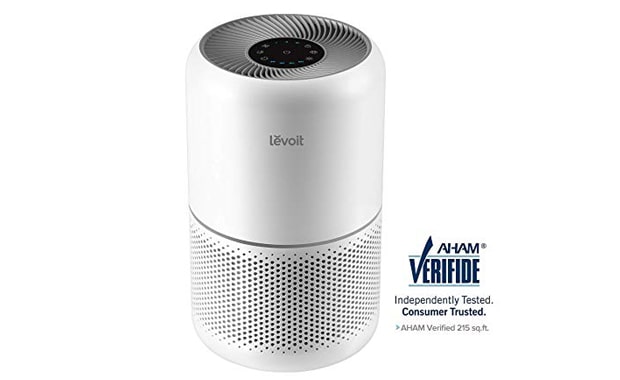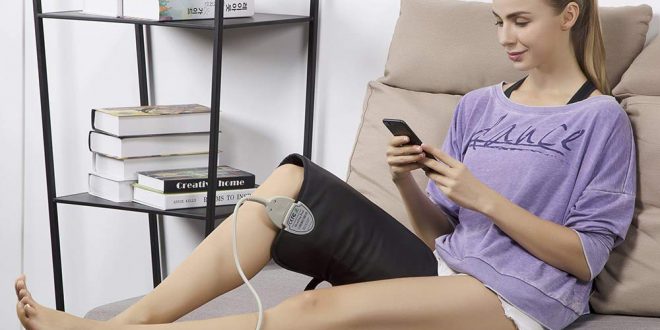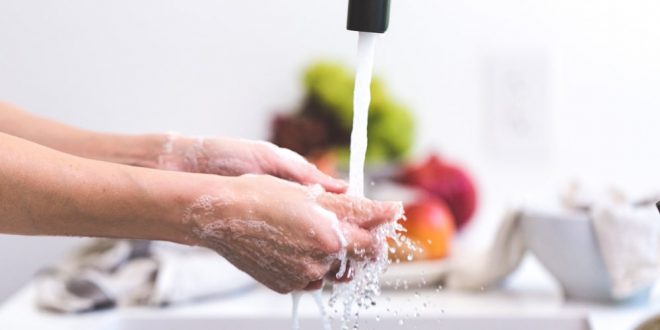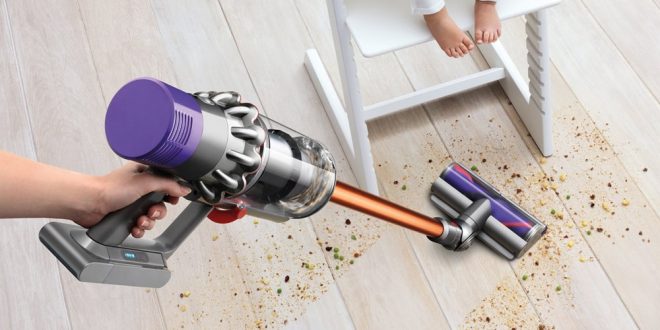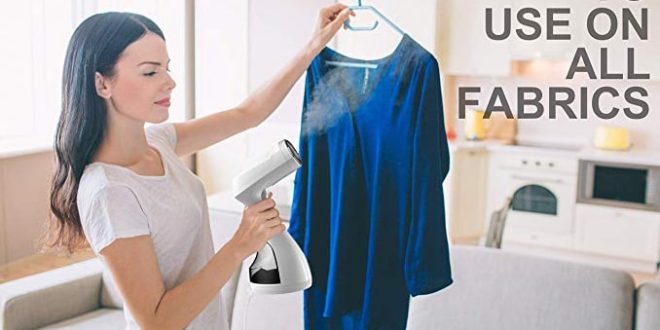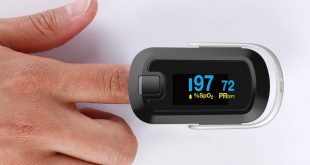Did you know that your indoor air may be more polluted than outdoor air? Well, polluted indoor air is the main cause of ailments such as asthma, itchy eyes and runny noses. Air quality may be poor in your home, but the good news is that you can monitor and improve your indoor air environment using an air purifier. These purifiers eliminate the unwanted and toxic air pollutants in your room while some also feature heating and cooling capabilities.
With the best air purifiers, you’ll rid your home of pollutants and regulate temperatures easily. Comfort and safety are two essential components in your home. Besides, according to the Environmental Protection Agency, if there is no fresh air cycling in your home, then air pollution in your home could exceed the outdoor air pollution by five times.
Related:The 10 Best Air Conditioners
Best Overall: Alen BreatheSmart Air Purifier for Large Room
Rated #1 in our review, Alen BreatheSmart is the best air purifier in the market. The purifier is durable and has a beautiful design. From a distance, you’ll admire the look of this device. Now, turn it on, and you’ll notice the change in the air quality of your room. It is ideal for anyone looking for a high-quality and long-term purifier. It is perfect for the living room, large rooms and comes with a HEPA Pure Filter that removes dust and allergens in your living room.
Besides, the device is fully customizable and has four types of filters that give you flexibility in choosing your purification needs. Moreover, if you’re into home décor, then the 14-panel color options give you more choices. Also, the device has a smart sensor that automatically detects the air and adjusts the device to suit your needs.
Alen brand is famous for its quality air purifiers, and this device is no exception. Enjoy the peace and calm home with a silent purifier. You’ll also love the extra safety and lifetime warranty that comes with this device.
Key Features
- HEPA-pure filter for removing allergens and dust
- Fully customizable with four different filter types
- The smart sensor adjusts the device basing on air to conserve energy
- Uses WhisperMax technology that operates with less noise
Specifications
- Brand: Alen
- Coverage Area: Up to 1100 square feet
- Power Consumption and Highest Settings: 105 Watts
- Product Dimension: 10 * 17.8 * 26.8 inches
- Product Weight: 21 pounds
- Reasonable price
- Good customer support and lifetime warranty
- It’s relatively quiet
- Leaves a fresh smell in your house
- The device makes an awkward noise at low fan speeds
Best Value: Dyson Pure Cool Link TP02 Wi-Fi Enabled Air Purifier
If you are looking for a purifier with dual functionality, then this is your best match. This device cools and purifies your air all year round, ensuring you have clean and fresh air in your home. What’s more, it’s highly effective and removes up to 99.97% of allergens and pollutants such as pollen, bacteria, pet dander and mold spores. It’s also compatible with Amazon Alexa.
With this device, you don’t have to worry about odors or organic compounds anymore. This is because it contains activated carbons that trap such air impurities, ensuring your home is allergen-free. It is manufactured using top quality standards as it has been accredited by Quietmark.
Well, you can also control this purifier wirelessly at the comfort of your seat using the Dyson Link app. You’ll also enjoy real-time control and monitoring of this device via your smartphone. The extra features such as the sleep timer, night-time mode and 10 airspeed settings make it a valuable addition to the living room. Besides, its aperture design enables you to clean it quickly, and there are no fast-spinning blades that can injure your fingers or paws.
Key Features
- 10 airspeed settings
- Air multiplier technology for circulating purified air around the room
- Includes voice control
- Automatic night-time mode including LED display dimming
Specifications
- Brand: Dyson
- Coverage Area: Up to 1600 square feet
- Power Consumption and Highest Settings: 60 Watts
- Product Dimension: 7.7 * 4.3*40.1 inches
- Product Weight: 7.9 pounds
- It is relatively quiet
- Easy to install and set up with Alexa
- The app allows you to set scheduled times to run
- The LED indicator has a night mode
- The fan has worked well with 10-speed settings
- Has a fragile plastic construction
- Thick and cumbersome chords
Best Pick: IQAir HealthPro Plus Air Purifier
Rated among the top three air purifiers, IQAir Purifier is the ideal modern device for getting rid of allergies and asthma. It is more effective than most HEPA air filters and offers users multiple speed settings. At the lowest speed setting, you’ll use less power while the highest speed offers you better air purification. Besides, it is manufactured using medical-grade materials that trap the smallest harmful particles in your room. These particles called ultrafine form 90% of the harmful particles in the air, and they are responsible for health conditions such as asthma, strokes, heart attacks and even cancer. This filer gets rid of these particles ensuring your air is safe and healthy for everyone.
You’ll also love the functionality of this device as it utilizes the latest triple-seal technology that prevents air leakage. The filter media in this purifier are sealed to the filter frame, and in runs, a 3D ultra-seal that attach the frame to the housing. Also, there are extra individual seals that ensure the device remains airtight. The new edition fan also rotates silently and utilizes less power to purify the air in your home. Besides, this device is programmable, which makes it possible to tweak the device to suit your needs.
Key Features
- Triple seal technology eliminates air leakage
- Six-speed settings offer users versatility depending on their air purification needs
- Power saving as lowest speed uses only 27 watts
- Individual seals ensure the device is airtight
Specifications
- Brand: IQAir
- Coverage Area: Up to 1125 square feet
- Power Consumption and Highest Settings: 215 Watts
- Product Dimension: 16 * 15 * 28 inches
- Product Weight: 35 pounds
- It has casters making it easier to move it around
- Works great and easy to set up
- Filters last a long time
- Removes smell and chemicals from the air
- It is quite expensive
- Filters are expensive
Best Mid-Range RabbitAir MinusA2 Ultra Quiet HEPA Air Filter
Popular for its stylish look, efficiency and energy-saving aspects, RabbitAir MinusA2 is perfect for those looking for a quieter and efficient air purifier. The device features six stages of purification and deodorization to ensure it purifies your air to higher standards. What’s more, the five-year warranty caters to the device in case you encounter issues or the device breaks down. Also, this device has a beautiful design and comfort, making it the ideal addition to your home.
The device has over three types of customized filters: germ defense filter, pet allergy filter, toxin absorber filter and odor remover filter. The germ defense filter has a sturdy construction and is useful in trapping and reducing spores, airborne bacteria and other particles that carry viruses. On the other hand, the pet allergy filter traps and reduces the pets’ allergens and danger. Toxin absorber filter traps the volatile organic compounds and other chemicals that can be harmful to your health. Also, if you regularly have to deal with odors from cigarettes, mildew or pets, then this device contains an odor remover filter that traps and reduces these odors leaving your room air fresh.
It’s ideal for typical residential use and covers up to 700ft of rooms. Also, it HEPA filters and is manufactured from activated carbon that is effective in removing household odors and particles.
Key Features
- Top-notch performance
- Smart, stylish design
- Advanced air filtration process
- High-end smart features
- Ultra quiet operation
Specifications
- Brand: RabbitAir
- Coverage Area: Up to 815 square feet
- Power Consumption and Highest Settings: 61 Watts
- Product Dimension: 24 * 22.8 * 9.8 inches
- Product Weight: 19.4 pounds
- The app is user-friendly
- Easy to maintain
- It is relatively quiet
- It works great in eliminating odor and allergen
- The filters are quite expensive and require annual replacement
Oransi Max HEPA Air Purifier for Asthma Mold, Dust and Allergies
Oransi Max HEPA air purifier is best for use in your bedroom or basement. It’s effective in removing dust, mold spores, allergies and others that can cause asthma and other breathing complications. Besides, it was rated #1 by the comprehensive university study of air purifiers. Moreover, this product is energy star certified and is safe to use as a baby purifier and also for sensitive pets. As soon as you install this product in your home, you will wave goodbye to the annoying nasal stiffness and enjoy cleaner and purer air in your home.
Besides, it is simple to use as you only need to plug it to a socket and enjoy fresh air in your room. The easy filter access and the intuitive user interface also makes it a handy addition to your home. Besides, it is built with the latest technology monitor that checks the air in your home and adjusts the device to ensure the purest air in your home. the device has three stages of filtration and is also ideal
Key Features
- Filter replacement indicators notify you of when to replace the filters
- High standard certified safety features
- Coded monitor on auto mode for monitoring and automatically adjusting the fan speed basing on air quality
- Activated carbon filter for trapping odors, smoke and gases
Specifications
- Brand: Oransi
- Coverage Area: Up to 600 square feet
- Power Consumption and Highest Settings: 90 Watts
- Product Dimension: 20 * 11 * 25.5 inches
- Product Weight: 19 pounds
- Easy to move from room to room
- Easy to change the filters
- Works well and comes with several settings
- Accurate and responsive air quality sensor
- It is quite costly
Molekule Air Purifier with Dual-Filtration System
If you have a room that is 600 feet square or less and you need an air purifier that will handle all your purification needs, then purchase this device. It can replace the air in your living room in only one hour, removing pollutants and ensuring the air is pure in your room. What’s more, the two filters: a pre-filter and PECO-filter provides the device with dual filtration. The pre-filter is effective in removing large particles such as dust, pet hair while the PECO-filter contains a catalyst that breaks down bacteria, VOCs, viruses and other pollutants that can pose a threat to your health.
Besides, you don’t have to worry about footing high energy bills every month from exceptionally high energy using the purifier. Instead, the device incorporates fans that use less power which makes it energy efficient. Also, it does not produce weird and loud noises as it uses a unique technology that enables it to operate quietly and efficiently. Also, you can connect to the device conveniently using a mobile app that connects via Wi-Fi. Or you can use the easy-to-use touch screen controls to operate the device.
Key Features
- Dual-filtration system ensures maximum trapping of small and large particles
- Unique technology makes the device quieter than other conventional air purifiers
- It uses low-powered fans making it energy efficient
- The natural leather handle makes it easy to carry and place the device anywhere in your home
Specifications
- Brand: Molekule
- Coverage Area: Up to 600 square feet
- Power Consumption and Highest Settings: 215 watts
- Product Dimension: 27.8 * 11.4 * 11 inches
- Product Weight: 28.1 pounds
- Easy to control using the touch-screen display
- It is compatible with Wi-Fi and can be controlled remotely with a smartphone app
- Works well in removing dust and leaves the air fresh
- Can be moved anywhere in your home easily
- The Wi-Fi and the phone app are pretty unreliable
Coway AP-1512HH Mighty Air Purifier
Rated #7 in our review, Coway’s AP-1512H air purifier remains one of the most popular devices on the market. It is designed to work different room sizes, ensuring the air remains clean and safer in its areas of operation. What’s more, its 4 stage filtration process offers you quality indoor air by removing odors, pollutants, allergens and volatile organic compounds in your home or office.
Besides, the device has a sensor that monitors the indoor quality air in real-time. The LED screen also displays how clean or dirty your room air is at a particular time. What’s more, the LED has a timer and filter lifetime indicator. The four fan speeds in this device give you versatility in picking the amount of air filtration you need. The auto mode also adjusts the fan speed basing on the indoor air quality and the fan automatically stops when the device doesn’t detect air pollution for 30 mins. This eco mode enables the device to save energy.
You’ll also find it easy to check when to clean your device as it has a filter replacement indicator. This indicator monitors both filters and alerts you when it’s the right time to replace them. The device also operates quietly making it efficient for office environments.
Key Features
- Covers up to 361 square feet
- Pollution sensor monitors and relays indoor air quality in real-time
- Three fan speeds offer you flexibility in choosing your air purification needs
- Timer feature allows you to select the period for running the machine
Specifications
- Brand: Coway
- Coverage Area: Up to 361 square feet
- Power Consumption and Highest Settings: 77 Watts
- Product Dimension: 16.8 * 9.6 * 18.3 inches
- Product Weight: 12.35 pounds
- The ionizer works pretty well
- The filters are reasonably priced
- Easy to set up
- Filters last for longer without necessitating replacement
- The fan can be noisy at times
Related:The 12 Best Air Compressors
Honeywell HPA300 True HEPA Air Filter
Well, if you have an extra-large room and you are looking for the best air purifier, then this device is your perfect match. It’s one of the top-rated air purifiers in the marker featuring turbo clean that removes pollen, particles and other pollutants in your room. With its 3 cleaning levels, it traps germs, odors and other particles to leave your air sparkly clean in your home. Besides, it is 99.97% effective in removing small airborne particles as small as 0.3 microns.
With this device, you’ll relax and breathe easy knowing the air is safe for you, your family and visitors. This is because the machine circulates and purifies air up to five times an hour in your home to ensure there are fewer particles, allergens, odors and volatile compounds. It can purify the air in rooms of up to 465 square feet and is suitable for medium and large rooms alike.
Key Features
- 3 cleaning levels ensures the removal of small particles and pollutants
- High-quality Hepa allergen filters for removing small airborne particles
- Its filters circulate air up to five times an hour to ensure cleaner air
- Suitable for extra-large rooms of up to 465 square feet
Specifications
- Brand: Honeywell
- Coverage Area: Up to 465 square feet
- Power Consumption and Highest Settings: 130 watts
- Product Dimension: 9.2* 20* 22.2 inches
- Product Weight: 21 pounds
- Setup instructions are easy
- Offers a great amount of filtration
- Produces pleasant white noise that is hardly audible
- This device is light making it easier to use at night
- Replacement filters are quite expensive
- Poor design for replacing the filters
Winix 5500-2 Air Purifier with True HEPA
Winix 5500-2 Air Purifier comes with one of the most effective HEPA filters in the market. It is ideal for removing airborne pollutants such as pollen, pet dander and other small allergens from your home. What’s more, its AOC carbon filter is washable eliminating the need for regular replacement. Also, the same filter is made from activated carbon granular, which is effective in removing household odors. Also, you don’t have to worry of allergens, chemical vapors and other pollutants as the device features a PlasmaWave that filters and safely breaks down these pollutants.
The smart sensors in this device also gauge your room air and transmit the results to the device. The auto mode feature then alters the fan speed to filter the air as required. But if you would like to adjust the fan speed manually, then the manual mode feature enables you to switch between low, medium, high and turbofans speeds. Low and medium provide near-silent cleaning while the high and turbo modes offer superior cleaning power and maximum airflow. Now when you feel like sleeping, then just turn the sleep mode on, and the device will dim the indicator lights and adjust the fan speed to ensure you enjoy a quiet and peaceful sleep.
Key Features
- Washable AOC Carbon filters for removing household odors
- Auto mode adjusts the fan speed to offer the desired air filtration
- Can filter the air for up to 360 square feet rooms
- Sleep mode features dim the indicator lights and fan speeds to enable you to enjoy a quiet sleep
Specifications
- Brand: Winix
- Coverage Area: Up to 360 square feet
- Power Consumption and Highest Settings: 70W
- Product Dimension: 15 * 8.2 * 23.6 inches
- Product Weight: 15.4 pounds
- Sturdy and durable hard matte plastic construction
- The three filters fit snugly in the filter chamber
- Intuitive and user-friendly control panel
- It is relatively quiet
- Comes with a remote control
- The filters are quite costly
- It is less effective in getting rid of smells
LEVOIT Air Purifier for Home Allergies and Pets Hair Smokers in Bedroom
Though it’s the last item in our review, Levoit Air Purifier is still a favorite choice among many air purifiers enthusiasts. It is ideal for rooms of up to 215 square feet rooms and offers superior cleaning performance. With this device, you’ll fill your home with cleaner and purer air. This is because the device has a HEPA filter, ultra-fine Pre-filter and activated carbon filter that traps microns and other pollutants in your room giving you fresh air. What’s more, you don’t have to worry about weird sounds as the device is almost soundless operating at only 24db. This reduces noise which enables you to sleep and rest in a quiet and peaceful environment.
Besides, the device has an excellent internal structure and durable high-precision bearing that increases the durability of the device. Besides, the device has a check filter indicator in the display that reminds you of the right time to replace your filters. Overall, it’s one of the best air purifiers in the market that also retails at a decent price. It is best for small and medium-sized rooms.
Key Features
- AHAM verified for its ability to remove dust, pollen and tobacco smoke
- Custom high-efficiency activated carbon filter for eliminating pet odors and cooking smells
- Upgraded filtration system for cleaner air
- Check filter indicator notifies you of when to replace the filters
Specifications
- Brand: LEVOIT
- Coverage Area: Up to 215 square feet
- Power Consumption and Highest Settings: 45 watts
- Product Dimension: 27.8 * 11.4 * 11 inches
- Product Weight: 28.1 pounds
- Easy to set up
- Fantastic design and super effective
- Has a big-air intake compared to its size
- Has a top-quality Hepa filter
- It is relatively quiet
- It has no handle which makes it hard to move about
- Offers no choice of filter types
Can Air Filters Help?
The best ways of improving indoor air are ventilating the room with clean outdoor air and removing pollutant sources. Portable air purifiers come in handy when these methods are less effective or impossible. Also referred to as air sanitizers, air purifiers are designed to clean the air in a single room and not the entire house like HVAC systems. And while they help in purifying indoor air, they have limitations on what they can do.
What Air Purifiers do well
The air purifiers in this review are effective in eliminating dust, smoke, and pollen from the air. Multiple studies of portable air show that using HEPA filters results in 50% or higher reduction in particulate matter. A 2018 study of about 130 households shows that filtration helped in reducing 30% of coarse particles such as dust in these homes.
But how does that impact our health? About a dozen studies done in areas such as Vancouver, British Columbia: Taipei, Taiwan, and Massachusetts focused on the cardiovascular effects and showed improved cardiovascular health among the participants. The EPA’s focus on these eight studies focuses on asthma and allergy symptoms and shows improvements in more than one area. Also, the University of California conducted a study (PDF) among asthmatics in 2018 and reported 20% lower clinic visits among participants.
However, the medical and scientific communities cannot link the use of these purifiers to the health benefits among participants as the health benefits are inconsistent, and there are few studies on this area. Besides, there were other variables in the study i.e., use of vacuum cleaner, pillow covers, and removal of pets that affected the final results.
What Air Purifiers Don’t Do
Air purifiers only capture allergens that are floating in the air. Larger and heavier allergens such as mites and pollen settle on the ground, quickly making it hard for the purifier to capture them.
What We Don’t Yet Know
According to EPA, radon is one of the blind spots for air purifiers and common air cleaners. There are fewer studies on air purifiers’ abilities in tackling this dangerous gas. There is insufficient research on the effectiveness of air purifiers in addressing general gaseous pollutants. Also, there is inadequate data on the effects of ionized air on the subjects’ health. This brings us to another subtopic, the types of air purifiers technology.
Types of Air Purifiers
There are numerous technologies that air purifiers use for tackling air pollution. Some can be better than others. Some are safer, while others are bad for your health.
Mechanical Filters. This is the type we test. These air purifiers have pleated filters with fans that force air through its dense of fine fibers that trap particles. Filter with very fine mesh are HEPA filters (they’re certified to collect 99.97% of particles of up to 0.3 microns in diameter i.e., smoke and paint pigments. These HEPA filters can also remove large particles such as dust, pollen, and some mold while suspended in the air. (Please note that some filters labeled “HEPA-like” or “HEPA-type” are not certified to meet the ideal true HEPA filters requirements but can still perform well in our tests.
As with its downsides, mechanical filters are not effective in trapping gases or odors. Besides, they can be too costly to maintain, and they require replacement after every 6-12months; they cost up to $200 per filter, but their average price is $80.
Activated Carbon Filter. Unlike mechanical filters that catch particles, sorbent filters use activated carbon that absorbs odor-causing molecules from the air. They can also get rid of some gases, but they are particularly effective in dealing with ammonia, formaldehyde, and nitrogen oxide. Because they don’t combat particles, most air purifiers feature an activated carbon filter and a pleated filter for catching particles. However, these filters saturate faster than pleated filters, and they, therefore, need regular replacement, that is, every three months, unlike 6-12 months for pleated filters. These filters also cost $50.
Currently. we are not testing for odor removal, but back in 2008, we tested five air purifiers that claimed to remove odor. We did our tests to ascertain the effectiveness of these machines in removing cooking odors. From the results, we proved that only two had such capabilities because of their thick and large carbon filters.
Ozone generators. These air purifiers produce ozone, a molecule that reacts with some pollutants to alter their chemical composition. This can result in unsafe indoor air, and we, therefore, don’t recommend them. Most manufacturers of these machines claim the devices emit safe ozone levels. Still, our past tests proved that some devices emitted ozone that exceeded the FDA’s limit of 0.05 parts per millions of medical devices. Besides, studies reviewed by EPA shows that low levels of ozone (the main component of smog) doesn’t effectively get rid of indoor pollutants. More studies also show that ozone is linked to decreased lung function, coughing, chest pain, lung tissue inflammation, and increased risks of throat irritation. Ozone can also worsen asthma, bronchitis, and emphysema, according to EPA.
Electronic air purifiers. Electrostatic precipitators and ionizers charge particles in the air so that they can stick to the device and nearby surfaces. They work like a magnet, but we don’t rest nor recommend them as they can produce ozone.
Ultraviolet germicidal irradiation (UVGI). Some manufacturers claim their air purifiers kill bacteria, viruses, and fungal spores using UV lamps. However, some bacteria and mold spores are resistant to UV rays. For it to work, the exposure must last for longer, and the rays must be powerful for the method to work. We don’t test UVGI technology, but some mechanical purifiers we tested have this functionality.
Photocatalytic Oxidation. PCO uses ultraviolet radiation and a photocatalyst i.e., titanium dioxide, to produce hydroxyl radicals that oxidases gaseous pollutants. Depending on the type of contaminant, the reaction can, at times, produce dangerous byproducts such as carbon monoxide, formaldehyde, ozone, and nitrogen dioxide. Currently, we don’t test for this technology though there have been few studies on the effectiveness of PCO air purifiers. One particular laboratory study by researchers of Syracuse University, New York, shows that the devices did not effectively remove any volatile organic compounds (VOCs) that are present in indoor air.
One manufacturer Molekule recently manufactured an air purifier called PECO. This is a variant of PCO, and from our tests, the device was effective in removing dust, smoke, and pollen.
What is a HEPA filter? And what does HEPA stand for?
High-Efficiency Particulate Air (HEPA) is the measurement standard for air filtering. HEPA filters are commonly used in medical facilities for minimizing the risks of spearing bacteria and viruses. Typically, medical-grade HEPA filters are used with anti-microbial (ultraviolet) filters in eliminating viruses and bacteria caught by the HEPA filter.
HEPA filters are a component of high-quality vacuum filters for trapping finer particles rather than kicking them to the air.
A majority of air purifier solutions claim that they have HEPA-graded filtering. However, since there is no regulatory authority that monitors the claims made by these manufacturers, it becomes difficult to get an efficient air filter as most domestic air purifier manufacturers also use HEPA-like filters that do not meet the medical standards of these systems.
Other manufacturers also claim to use HEPA grade filtering, but they fail to offer crucial information on the same such as coverage and filter efficiency. Some do not provide any pre-filtering of large particles such as smoke.
How to Clean a HEPA filter?
The answer is No. You can’t clean a HEPA filter. While some air purifier manufacturers claim to have washable HEPA filters, the best option always is to replace the filters. We know that it sounds wasteful and costly, but washing these filters disintegrates the ultra-fine fibers that trap dust and air pollution. Therefore, you’ll degrade the 99.97% efficiency of these machines.
This is especially important if you’re using the air purifier for medical purposes. Washing the filters put the machine’s filtering efficiency at risk.
If the indicator on the device is showing you it’s time for a filter replacement and you don’t have an extra unit at hand, then you can clean the air purity sensor using a cotton tip or give the device a light vacuum using a soft brush head.
Most brands have also set sustainability goals for these air purifiers. For instance, Philips air purifiers are made of over 90% recycled materials.
How to size your room size?
If your bedroom is a 300 square foot size and built with a 10ft high ceiling, then it is 3,00 cubic feet. For two cleansings per hour, you should move 6,000 cubic feet per hour through the filters. Since CADR is measured per minute, you would have to then divide 6,00 by 60 to get 100DR.
For those suffering from allergies and asthma, the air changes number should be higher like 4. So in our example, you’ll have to then move 12,000 cubic feet per hour. This corresponds to 200 CADR rating.
Again, this number is the highest fan speed setting in 10 feet high ceilings. If your ceiling is therefore 8 feet higher than the math would change.
If you lower the fan speed, then you’ll get a lower CADR and therefore lower the air cleaning ability.
Hope this makes sense. As I was writing this I realized it was becoming more complicated than intended. But the easier way is to multiply the CADR by between 1.6 and 3. If you want your air filtered every 12-15 minutes then use 6 but if you want it filtered every 30 minutes then use 3.
The bottom line is while comparing air purifiers always look at the CADR. A bigger number means better airflow through the filters which are important especially if you have a larger square footage room to clean.
Things to Consider While Shopping for an Air Purifier
- Cost of Replacement Filters: In general, you should replace filters (or clean the washable) after every 6-12 months for pleated filters and 3 months for activated carbon filters. Most of the units in our review have indicators that show you when to replace or clean them. The cost of filters widely varies but for large purifiers, they range between $20 and $200 unit. Filters with odor-removing carbon may cost up to $50.
- Certifications: There are many labels you should look for in a package. The first one is the Energy Star logo. Air purifiers should be effective around the clock and power-saving too which is the reason you should for Energy-star certified products as they are more than 40% energy efficient than regular purifiers.
Also, there is an AHAM Verified seal which shows that the Association of Home Appliance Manufacturers has tested the model. Though not critical, most devices have undergone this test to ensure clean air delivery rates CADRs) and room size guidelines on its seal.
CADR reflects the volume of air that a purifier can generate on its highest setting in cubic ft. per minute. Therefore, the highest the CADR the more effective the air purifier. Portable air filters that contain HEPA filters have the highest CADR. From our review, a CADR above 240 gives an excellent rating, 180-240 (Very Good), 120-179 (Good), 60-119 (Fair), 60 and below (poor).
There are different CADR ratings for removing dust, tobacco and pollen. Therefore, you should choose a purifier basing on the CADR rating of your main pollutant. Therefore, if you live around a smoker or fireplace, then buy an air purifier with higher CADR for tobacco smoke.
- Room Size: If your air purifier has an AHAM Verified seal, then you can trust that unit to handle the room size indicated on the seal. However, be wary of some manufacturer’s claims as we have tested some air purifiers that are not suitable for their indicated room sizes. Check our ratings to see the suggested room-size ranges for each model. Also, some models that are ideal for large rooms (350 square feet and up) work well at low speeds which is important when you are sleeping or watching TV.
- Noise: Judge your air purifier based on its performance and noise aspects. These machines run most of the time and should, therefore, be quiet (for reference, 50 decibels [db] of noise is similar to that of a refrigerator). Check the decibels that a model operates on from its packaging or website listing before buying it. Alternatively, check the air purifier ratings as we rate their noise levels at lower-speed and high-speed settings.
Another important tip for lowering the noise is running the air purifier on high settings when you are out of the room and turning low-settings when in the room. You can also buy an air purifier designed for larger rooms so that you’ll use the lower speed to filter more air.
- Ease of Use: Ease of use doesn’t include the performance of an air purifier. Therefore, we include it in the rankings as a preference. We prefer simple and portable units. We’ll be taking note of some features of the models for future reference.
Therefore, if you care less about these, then pay closer attention to efficiency and airflow results. Our target is to give you more information so that you’ll get the best air purifier for your condition.
How to Get the Most Out of Your Air Purifier?
- Clean or replace filters regularly: As a general rule, you should replace (or clean ones that can be vacuumed) pleated filters every 6-12months. For carbon filters, replace them every three months.
- Place it wisely: If you have only one unit, then it’s best to place it in the room where you spend the most time. The bedroom is a common spot for many people. Air purifiers can be heavy and clunky to move around and it’s therefore vital to buy a machine for each room if you want to use it in multiple rooms. Also, place the device on a location with no obstructions such as curtains.
- Keep your purifier running 24/7: Keep the doors and windows closed while using the device. We recommend using the machine at high settings when not in the room and low settings when in the nearby.
Frequently Asked Questions
Q: Do air purifiers work?A: Yes, provided you have the right filters and enough airflow for your room’s size. You’ll need a HEPA filter for airborne particles and an activated carbon filter for smoke, gases and chemicals.
Q: What is the importance of an air purifier?A: A good air purifier will make your indoor air cleaner. You’ll, therefore, avoid allergies, sleep better and wake up feeling less congestion in your room — also, its effective in eliminating smoke odors.
Q: How can I improve air quality in my home?A: Using an air purifier is the best way to improve the air quality in your home. However, cleaning also makes the purification job easier. Carpets hold a lot of pollen, dust and other irritating particles (in fact people with asthma and allergies should live without carpets). The use of a vacuum with HEPA filters is also the best way to improve air quality in your home.
Q: Do CADR ratings measure gaseous pollutants A: No, while the CADR testing method gives you an accurate representation of the purifier’s ability to purify the air, it is not perfect. It doesn’t measure gaseous pollutants and smaller particles. That said, CADR ratings are the best resources to use now, and they’re trusted by organizations such as the Consumers Union and EPA.
Q: Is the air more polluted indoors or outdoors?A: You may think that the outside air is more polluted, but that’s not the case. According to studies by the Environmental Protection Agency (EPA), the air inside can be 2-5 times polluted with soot, animal dander and cigarette smoke.
Q: Do large air purifiers have better CADR ratings?A: Yes, the largest purifier we tested, the Honeywell HPA300 maxed out at 465 square feet and had the highest CADR ratings. However, that extra coverage is expensive, and the Honeywell retail price doubles the Winix 5500-2 cost.
Q: What are the benefits of an air purifier?A: Better air quality promotes a healthier lifestyle and a cleaner home. Air purifiers can reduce triggers for asthma and seasonal allergies by eliminating allergens such as dust, odors and pollen. They also trap airborne particles such as asbestos, bacteria and minimize carbon dioxide level while also removing volatile organic compounds to lower the risks of developing severe diseases.
Q: How do I know if I have an indoor air quality problem?A: Identify the sources of air pollution that may exist in and around your home. These include household cleaning products, pet dander and tobacco smoke, etc. also, areas with poor ventilation in your home can cause condensation on walls and windows. Air purifiers help with these problems. If you’re worried about contaminants in your home, use an allergen test kit, or indoor air quality monitors to identify various pollutants in your home.
Q: Where should I place my filter?A: Place the air purifiers where you spend your time most. If you work most time and come home late to sleep, then put it in the bedroom. Also, if you enjoy cooking, then the purifier will help you clear kitchen air contaminants. For those who love watching, place it in the living room.
When it comes to filters, there are many decent types you can try in the market. Few are great, and they can improve the quality of your life well. These machines are powerful enough, and they’ll clean the air in your living room. Also, they are quietly enabling you to enjoy a sound sleep while using them. Choose an air purifier.
 Best Wiki
Best Wiki

